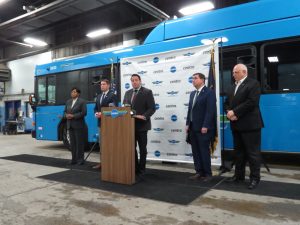A proposed federal law that would provide a semiconductor incentive, scientific research, and “technological competitiveness” to bring manufacturing back from overseas to places like upstate New York will soon get a vote in the U.S. Senate.
U.S. Senate Majority Leader Charles Schumer (D–N.Y.) on Thursday discussed the measure with reporters around New York during a Zoom call.
“This is a game changer for upstate New York,” Schumer said in beginning his remarks. “This will create more good paying jobs in upstate New York than anything that’s happened in decades.”
(Sponsored)

Ask the Expert: How Companies Can Future-Proof Their Workforce
In today’s landscape, workforce challenges are more pressing than ever. Across New York and beyond, companies are grappling with unfilled positions, skills gaps, and increasing turnover. These challenges can slow

7 Cyber Security Essentials to Check Off
By Bogdan Bagovskyy vCIO Along with back-to-school season, Halloween decorations hitting the shelves, and the beloved pumpkin spice latte making its reappearance, there’s another often-overlooked event this fall: National Cybersecurity
The bill got the necessary 60 votes for passage this past Tuesday and will pass in the Senate in the week ahead, Schumer said. It’s called the United States Innovation and Competition Act of 2021, or USICA.
Schumer contends the bill would “directly help alleviate” the current supply-chain crisis that has increased costs for families, worsened inflation, and presented a national security threat due to the critical lack of microchips.
“What does it mean? A surge in federal dollars into research and development, tech hubs, and create the first federal incentives for bringing semiconductor manufacturing back to the U.S., and more importantly, to upstate New York,” Schumer said. “$50 billion to incentivize domestic microchip production and a tax credit as well … as well as money for our wireless communications supply chain.”
The senator went on to explain the significance of microchips, noting that “they’re in everything … everything.”
They’re “vital” to our national defense. Each javelin missile has 200 semiconductors. “China’s trying to dominate this industry. We can’t let them for our national security,” Schumer said.
To average New Yorkers, semiconductors are also “vital.” They’re in cars, appliances, refrigerators, phones, and tech devices.
“And if you want to know why you’ve been waiting so long for a car … why the prices of these things have gone up …. it’s because there’s a shortage of chips, so getting chip production here in the United States, not in China, will help greatly reduce our costs,” he said.
Regional impact
Schumer called upstate New York “one of the best places for making chips … in the whole country.” New York is currently home to more than 80 semiconductor companies that employ over 34,000 New York workers, including firms like Wolfspeed near Utica.
The majority leader also used his Thursday remarks to outline what the semiconductor bill will mean for specific regions of upstate New York.
In Central New York and the Mohawk Valley, major sites like the Marcy Nanocenter and White Pine Commerce Park in Clay are “already attracting interest” from large semiconductor-related companies because of their “shovel ready infrastructure,” Schumer’s office said. The lawmaker said his legislation would be the “lightning rod” for luring more jobs to Central New York and the Mohawk Valley.
The industry has already taken notice, as highlighted by Cree-Wolfspeed’s $1.2 billion investment to build the world’s largest 200mm silicon carbide semiconductor facilities in Marcy, which will create over 600 jobs.
Schumer also noted that Syracuse tech companies like JMA Wireless would be able to take advantage of other historic incentives like the $1.5 billion in 5G and telecom tech development that could accelerate their expansion locally.
In addition, the research and development (R&D) investments included in the bill will support the region’s efforts in drones and quantum computing.
In the Southern Tier, Schumer said the greater Binghamton area has already emerged as a “growing hub” for battery manufacturing. And with Binghamton University (BU) as a finalist in the U.S. Economic Development Administration (or EDA) $1 billion Build Back Better Regional Challenge for its battery R&D proposal, Schumer said his bill could strengthen this plan even further by helping grow this critical supply chain in the Southern Tier. The Build Back Better Regional Challenge is part of the federal American Rescue Plan Act of 2021, or ARPA.
In addition, research schools like BU and Cornell University would be able to enhance their efforts through more federal research dollars and bolstering their workforce-training initiatives.




